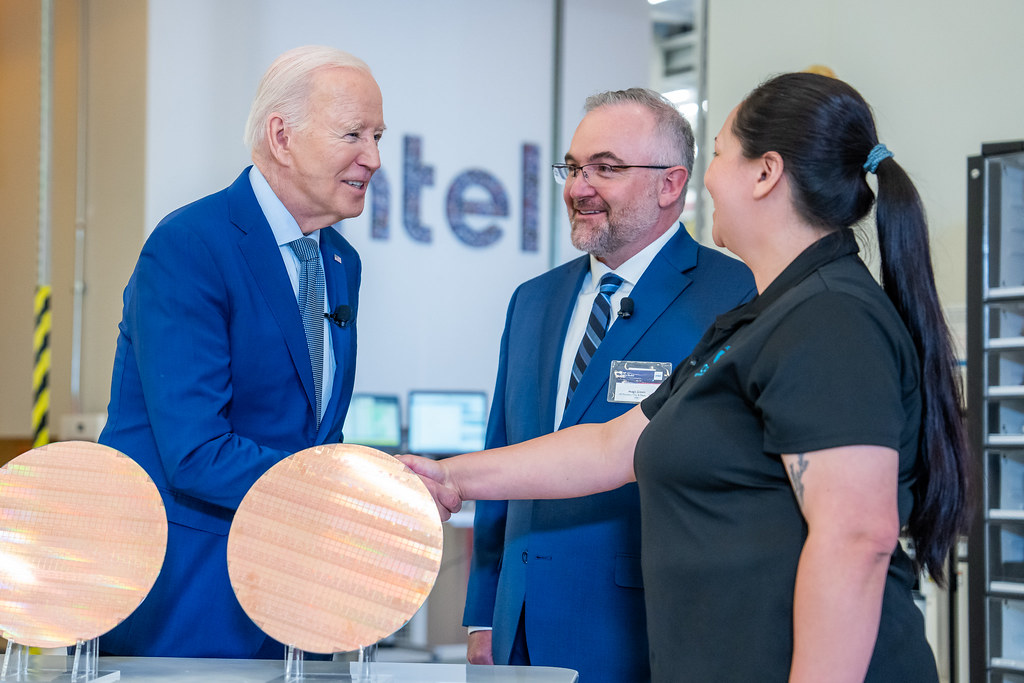
Officials see opportunity for greater investment in AI research and development for improving semiconductor manufacturing.
The White House sees promise in artificial intelligence to drastically impact semiconductor manufacturing technology that is becoming more complex and requires more resources.
“We’ll see materials for semiconductors that are co-optimized not only for performance, but that can now address important issues like supply chain resilience and critical sustainability, both for existing and known materials, but potentially for new materials that we’ve not even thought of before,” said White House Office of Science and Technology Policy Director Arati Prabhakar at a June 13 White House event.
President Biden’s CHIPS and Science Act prioritizes funding for semiconductor technology, which makes up critical components of things like cars, appliances and also defense weapons systems. The plan aims to increase U.S. leadership in chip technology production and reduce relying on Asia for it.
Federal leaders met at the White House event to discuss potential for AI in semiconductor manufacturing. The effort is part of a broader plan called AI Aspirations to explore how AI can used in research and development in other industries including health, education, weather and more.
With semiconductors, a major challenge is time. It takes close to a decade to design new materials that are required in new chips. This is where officials say AI could make a difference.
“We’ll never get there by doing the way we normally do experiments the way we were taught to do it; we need something like artificial intelligence. But even that’s not enough,” said Benji Maruyama, senior materials research engineer at the Air Force Research Laboratory’s Materials and Manufacturing Directorate. “We need to invest more experiments in it, but also more understanding, more simulation so that we can have better knowledge.”
Incorporating AI in the production process is pretty technical, and manufacturers would need enormous amounts of data to feed AI models and train them. This is because critical-dimension scanning electronic microscopes (CD-SEMs), a dedicated system for measuring dimensions on a semiconductor wafer, become more complex and need greater amounts of data to map the dimensions.
“The CD-SEMs have to be digitized, and enough of the correct dimensions of the CD-SEM have to be fed back into the AI model in order to attain precision,” said Melissa Grupen-Shemansky, CTO and vice president of technology communities at the industry association SEMI. “You’re looking at an order or two orders of magnitude more than that for the actual data points necessary.”
NIST Group Leader in Data and AI-Driven Materials Science Francesca Tavazza said material and AI scientists must think about the right features or ingredients when creating models. She said these models aren’t a black box where more data is added in an attempt to make a better model, rather they’re following scientific laws throughout the process.
“We have to understand the source of the key ingredients that make physical phenomena occur, and those are what we put as an input in the model,” Tavazza said.
White House OSTP Principal Assistant Director for Industrial Innovation and Special Advisor for CHIPS R&D Dana Weinstein outlined a vision for a materials accelerator where AI could help reduce the time to deploy advanced materials from up to 20 years down to 1 to 3 years. Part of this will be incumbent on strong partnerships.
Incentives for research labs, industry partners and start-ups to be a part of the conversation could help eliminate bias and other challenges from the start. Tom Kenny, an engineering professor at Stanford University, noted that during his time with DARPA he learned about the importance of incentives to foster partnerships between government, industry and academia.
“Often you gather a lot of capital government funding and match funds, and you simply place that money midway between the academics and the industry,” Kenny said. “At DARPA, we launched programs primarily by identifying a vacant location between the communities that we were excited about trying to lure together. The CHIPS Act is a great opportunity to create teams out of the incentives of wanting to work together around substantial resources.”